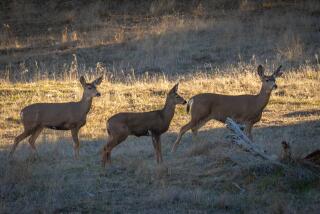Deer mouse
- Share via
[PEROMYSCUS MANICULATUS]
Imagine retreating on a cold, rainy or snowy day into a cozy nest of delicately shredded fibers. You’d nibble on a stockpile of seeds and nuts between naps and occasionally wander out on short foraging runs to check the weather. Such is the winter world of California’s most abundant and widespread mammal. Despite being on the menu of many forest predators -- snakes, owls, weasels -- deer mice flourish throughout the state because they occupy every terrestrial niche from tree line to ocean beach. Through their numbers, deer mice exert a profound influence on ecosystem dynamics, especially in the spring, when they emerge from their nests to feast heavily on the grubs and caterpillars that harm forest plants.
NATURAL HISTORY
Deer mice reproduce relentlessly. Sexually mature at just a month old, females bear multiple litters each year. Populations are cyclic, however, nearly disappearing some years and exploding others.
KEY CHARACTERISTICS
Unlike the drab gray city-dwelling house mouse, the deer mouse is sharply attired with fur that is soft brown and pure white.
More to Read
Sign up for Essential California
The most important California stories and recommendations in your inbox every morning.
You may occasionally receive promotional content from the Los Angeles Times.













